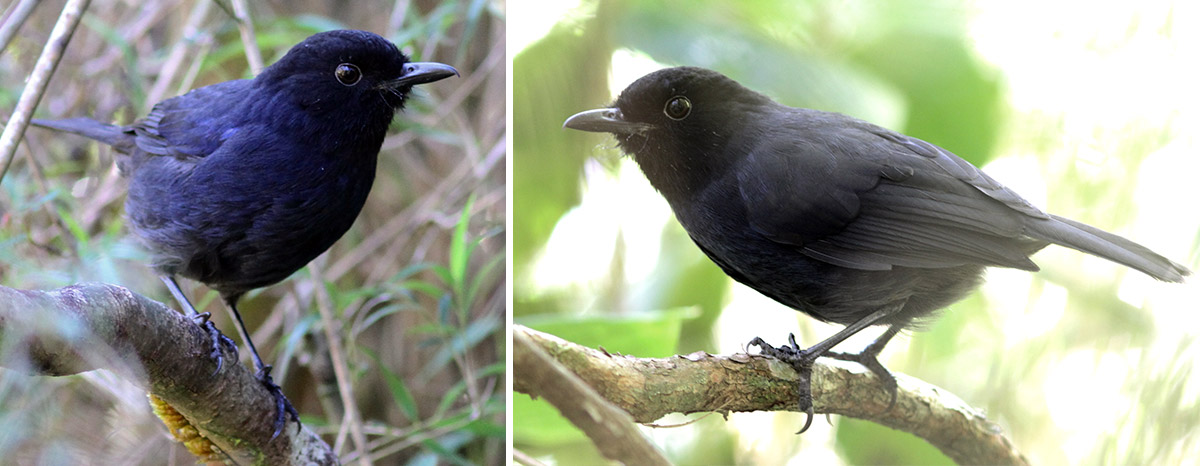
During the early evening, we parked the minibus in an unassuming pullout and all exited the vehicle. A small copse of native forest, tucked among extensive tea plantations, filled a ravine in front of us. We had come to this spot to look for one of Sri Lanka’s trickiest endemic birds, the Sri Lanka Whistling-thrush (Myophonus blighi). We hiked down a short, steep section along a narrow path and then positioned ourselves on the edge of the forest with the ravine and a tumbling stream below us. Now we waited, listening to the sounds of the forest as birds headed to roost. A noisy pair of Yellow-eared Bulbuls passed by, a fairly common endemic confined to the highlands of Sri Lanka. As things quietened, we could finally hear the soft cheeps of Sri Lanka Whistling-thrushes calling in the gully below. This whistling-thrush is endemic to higher elevations in the southwestern corner of the country, where it prefers dense forest along creeks or ponds.
We carefully scanned the thickets and looked deep into the shadows. The birds kept calling unseen, although a quick movement may have been it. Just as the light was fading and it seemed unlikely that the thrushes would show, a silhouette emerged from the thicket in front of us and hopped onto a bare branch perfectly visible against the vestiges of sunlight on the western horizon. The bird called loudly now and we all stood in amazement. We used a weak torch to brighten the bird a bit and were able to see the deep blue and turquoise tones of this understated whistling-thrush. It then flew off into the trees uphill from us. We celebrated our success and good fortune, but the evening was not finished. As darkness was quickly overtaking dusk, a large shadow appeared and we looked up just in time to see a Large Brown Flying Squirrel glide above us and then come to a sudden stop on a massive tree trunk. We were able to get great views in the torchlight of this nocturnal critter before walking back to the vehicle and calling it day.
The island nation of Sri Lanka is one of the finest birding destinations in Asia. It offers a bit of everything, a great introduction to birding on the Indian subcontinent, an excellent diversity of endemics, and a plethora of other wildlife that is generally easy to observe. More specifically, there are 34 bird species endemic to Sri Lanka with a further 20 near-endemics that are mainly shared with India. In addition, several species of large water birds like storks and pelicans plus large raptors that have declined in other countries are still plentiful in Sri Lanka’s numerous national parks and wildlife reserves. Combining the great birding and wildlife experiences with some flavorful food, captivating culture, and wonderful landscapes all adds up to a perfect birding adventure. All of Sri Lanka’s endemic bird species can be found in the southwest corner of the country where highland areas, lowland rainforest, and dry woodland are easily accessed within a network of well-protected national parks. In a little less than two weeks’ time, it is possible to observe all of Sri Lanka’s 34 endemics alongside all of the near-endemics and specialties.
After our successful stake out of the Sri Lanka Whistling-thrush, we were elated, knowing that we had seen one of the tougher species unique to the island. We wouldn’t be able to coast to a finish, but realized we had pretty good chances of “cleaning up”. While the majority of Sri Lanka’s endemics are relatively easy to see there are enough skulkers and rare species to keep things exciting, sometimes right up to the eleventh hour. Instead of talking about all the species possible during a Sri Lanka tour (240-250) let’s highlight the top twenty endemics that can be found, and yes, there will be lots of Sri Lanka this and Sri Lanka that! The following twenty species are described in no particular order.
Sri Lanka Spurfowl (Galloperdix bicalcarata)
This species is readily heard as it croaks from the undergrowth, but seeing this shy bird of dense forest is another matter. It is a small species of spurfowl, with whitish streaks and flecks on dark plumage. The red bill and facial skin are fairly striking. It could rank as one of the trickiest endemics, but fortunately a pair has taken a liking to a backyard in the small village on the edge of the Sinharaja Forest Reserve. It is now a rite of birding in Sri Lanka to spend a morning waiting in the small yard where Sri Lanka Junglefowl, the secretive Slaty-legged Crake, and a host of other endemics all visit to feed on scraps and rice. With luck, the furtive spurfowls will sneak in. Otherwise, with patience it is possible to catch a glimpse of these game birds in Kitulgala or inside the forest of Sinharaja.
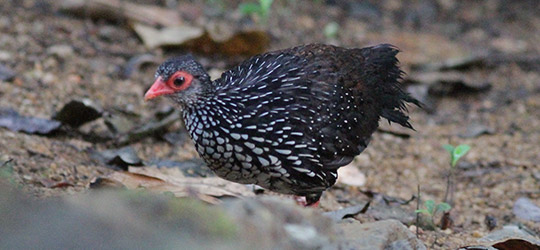
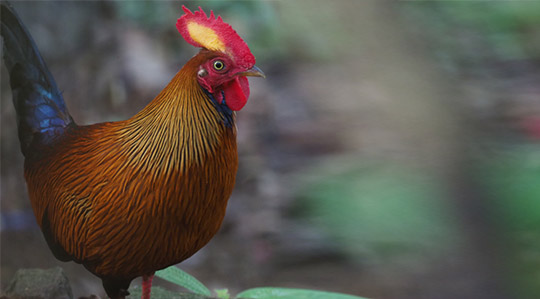
Sri Lanka Junglefowl (Gallus lafayettii)
In contrast to the previous species, it would be difficult to name a more extroverted endemic than the Sri Lanka Junglefowl. They DO follow birders around on trails just like chickens and are attracted to handouts. But make no mistake, this isn’t your ordinary rooster and has a strikingly different appearance from the Red Junglefowl of the mainland. The red comb has a golden-yellow center and the neat plumage fades from yellowish to a deep rust color with a purplish glossed tail. Overall, the Sri Lanka Junglefowl looks more elegant, although some of that refinement is lost when they come running after people. It is definitely one of the easiest endemics to see well, but it is still a treat to realize that the rooster crowing outside the lodge at Sinharaja is not just a chicken.
Sri Lanka Wood Pigeon (Columba torringtoniae)
This large pigeon is by no means common and can be difficult to find as it exhibits some nomadic and attitudinal movements. Once located it sits still for long periods in the canopy where its yellowish bill, lilac to maroon underparts, and ruffled collar of white and black are easily seen. Fortunately, there are a few reliable spots around the highland city of Nuwara Eliya and Horton Plains National Park where this endemic can be found. Occasionally, birds will descend to watering holes very early in the morning where they can be closely observed and photographed.
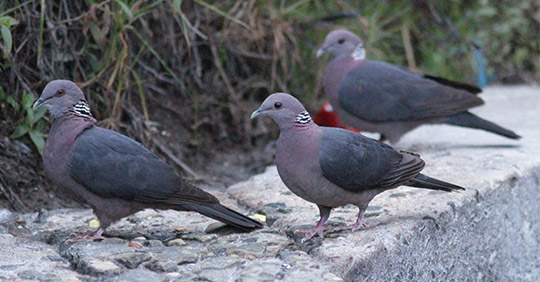
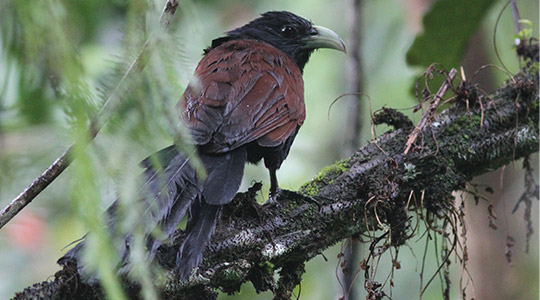
Green-billed Coucal (Centropus chlororhynchos)
The Green-billed Coucal is the smaller, forest dwelling cousin of the Greater Coucal, with the latter being widespread and regularly seen in open habitats in Sri Lanka. The Green-billed Coucal on the other hand is a true skulker, although its deep hooting calls are frequently heard. With a bit of patience and some luck it is possible to follow its vocalizations. Moving vegetation is the first clue to its whereabouts as it creeps mammal-like through the densest tangles and the best method is to stand back, wait, and let the bird hop into the open. Once settled on a branch, Green-billed Coucals will often stay in place, especially when calling. The namesake bill is actually chartreuse yellow and the wings are a darker chestnut than the sympatric Greater Coucal. While this species is not uncommon in dense forest and wooded plantations it may take a few attempts before one can get a good view.
Red-faced Malkoha (Phaenicophaeus pyrrhocephalus)
This uncommon endemic is restricted to wet forests in the south of Sri Lanka and even in ideal habitat it occurs at low densities. Despite being a large bird, almost fifty centimetres in length with a broad tail, the Red-faced Malkoha can quickly vanish from view as pairs clamber about the tall, dense canopy of the rainforest. The species is also relatively quiet and inconspicuously follows feeding flocks. The best place to see this declining and vulnerable species is at Sinharaja Forest Reserve, where it is best to search for feeding flocks and patiently scan through them to locate this prized endemic. If seen well the namesake face color is very obvious; composed of coral-colored bristles surrounding a bright eye. The bill is lime green. The glossy green upperparts are offset by gleaming white underparts. Due to its elusive and mobile nature, it is always a relief once everyone in the group had good views of this stunning species.
Serendib Scops Owl (Otus thilohoffmanni)
This is often the most wanted endemic for any birder visiting Sri Lanka. The Serendib Scops Owl was long shrouded in mystery and not officially described to science until 2004. Its limited range, secretive habits, and soft, frog-like vocalizations all contributed to it being overlooked. It is a very distinctive scops owl with an unusually long bill, orange-yellow eyes, a relatively undefined facial pattern, and with distinctive, black triangular spots on rufus underparts. These owls appear to occur at low densities in rainforest and secondary growth in a few localities in the wettest parts of Sri Lanka. They are strictly nocturnal and not easy to find, but fortunately local guides have intimate knowledge of the species and can locate one or two on day roosts. During previous tours, my groups have been able to celebrate on the first day of the tour as we tracked one down immediately upon arrival in Kitulgala, while other groups had to wait anxiously until the final afternoon of the tour in Sinharaja. Sometimes, an owl roosts very close to a trail and at other times a trek into the dense rainforest up steep hillside is required to see this gem. It is simply amazing how local guides consistently find these well camouflaged owls, since they snooze in the densest tangles, mimicking fallen leaves stuck among branches.
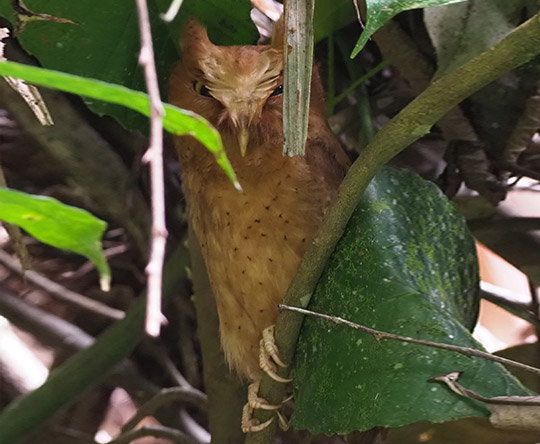
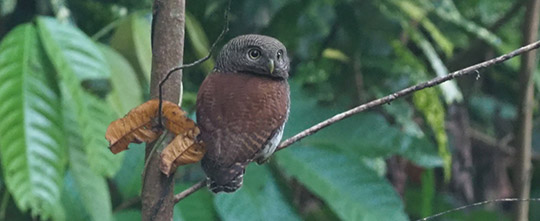
Chestnut-backed Owlet (Glaucidium castanotum)
Everyone enjoys observing owls, particularly small owlets that are diurnal. The Chestnut-backed Owlet is best seen in the plantations around Kitulgala where the open nature of the forest makes them easier to spot. It is restricted to wetter habitats in Sri Lanka. The species is quite vocal in the early morning as pairs patrol their territory, hunting mostly for insects, but also take mice, lizards, and small birds. The other congeneric species occurring in Sri Lanka, the Jungle Owlet, lives in drier areas.
Yellow-fronted Barbet (Psilopogon flavifrons)
This species is widespread throughout the southwestern portion of Sri Lanka where its double or triple notes are a signature background sound. Like many barbets, it prefers to remain in the canopy, but can be tracked down in more open forest or forest edge. Pairs nest in cavities excavated in softwood trees and the species feeds on a variety of fruits and berries. A fruiting fig tree can be full of these medium-sized barbets where the overall green plumage blends in well, but in the scope the blue face and golden forecrown are obvious.
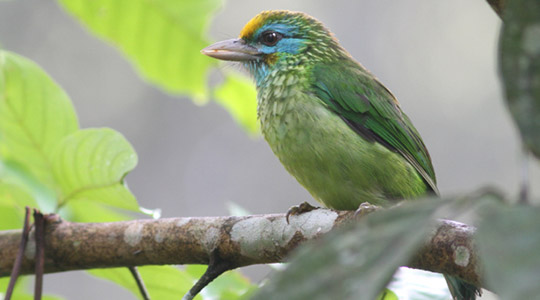
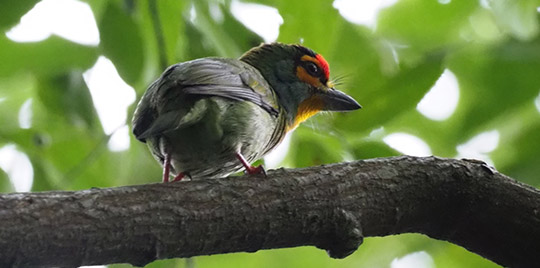
Crimson-fronted Barbet (Psilopogon rubricapillus)
This small and colorful barbet is much less common than the previous species and requires a concerted search to find. Like the previous species it is monotypic and has a distinct facial pattern: a yellow throat, yellow around the eye, and red forehead bordered by black. The remainder of the body plumage is a regular barbet-green. A staccato of tok notes leads the observer to the right tree, but spotting this small bird calling from the canopy can require some patience. It appears to be more common in the central and northern part of the country. In the southwest corner it is uncommon, but the forest edge and plantations around Kitulgala are a regular spot.
Red-backed Flameback (Dinopium psarodes)
This medium sized woodpecker is the “newest” Sri Lanka endemic. It was recently split from the Black-rumped Flameback, which occurs in northern Sri Lanka where it is represented by an endemic subspecies (D. b. jaffnense). The Red-backed Flameback is restricted to the south and differs by having a scarlet back fading to deep red, slightly longer bill, and likely a louder, higher pitched call. A study in 2016 showed that a stable hybrid zone of about sixty kilometres exists in central Sri Lanka, where birds with intermediate characters occur, for example with orange upperparts. Since the area of hybridization appears to be limited, the Red-backed Flameback remains classified as a distinct species. In the southwest corner of the island, where the majority of visiting birders travel, all flamebacks are pure Red-backed.
Crimson-backed Flameback (Chrysocolaptes stricklandi)
While the previous species is taxonomically very interesting, this hefty flameback is a more impressive woodpecker. It is never common, but mature forests around Kitulgala and Sinharaja are good bets to see it, even highland forests in the Horton Plains support this species. The larger size, pale eye, more extensive black on the face, and pale bill all set it apart from the sympatric Red-backed Flameback.
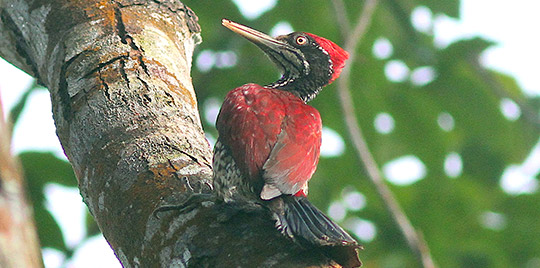
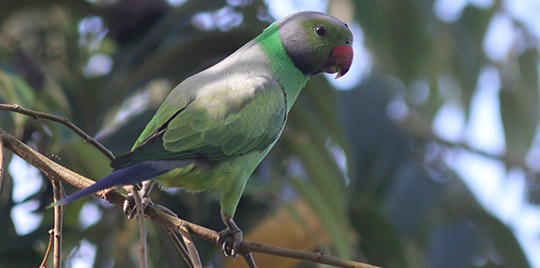
Layard’s Parakeet (Psittacula calthrapae)
This endemic parakeet is mainly found in hilly to highland areas, where it travels in small, noisy groups in search of fruiting wild figs and cinnamon. Three more widespread species of parakeets occur in Sri Lanka, but the Layard’s can be distinguished by its grey back and crown with a deep green collar. The alternative name of Emerald-collared Parakeet has been used by some taxonomies.
Sri Lanka Hanging Parrot (Loriculus beryllinus)
These tiny parrots shoot like “green bullets” through the canopy and I have seen more than one birder with looks of dismay as they missed another rapid flyby. Fortunately, this species is very common and while most views are of chattering blobs that zip past, soon enough a group will settle into a fruiting tree. Here, these hanging parrots can be studied at leisure and the pale eyes and red crown set them distinctly apart from similar species.
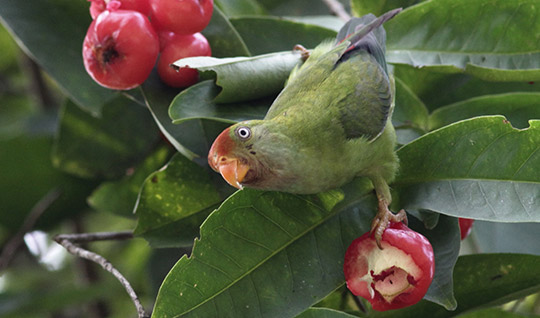
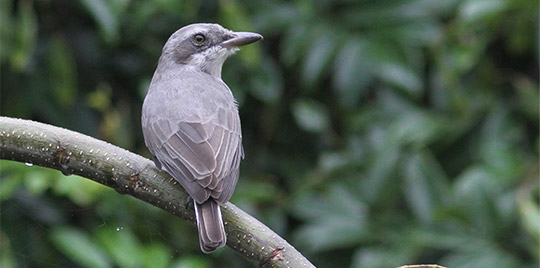
Sri Lanka Woodshrike (Tephrodornis affinis)
This is the only Sri Lanka endemic that is restricted to the dry zone. It prefers open, deciduous forest where it moves about fairly sluggishly in pairs or small family groups. Field marks that set it apart from similar species on the Indian subcontinent are a pale to dusky iris, shorter tail, and reduced whitish supercilium. An excellent place to come across this range-restricted species is Yala National Park along the southern coast. It is also common in the northern part of Sri Lanka.
Sri Lanka Blue Magpie (Urocissa ornata)
This is the classic and classy endemic of Sri Lanka, a combination of colors that are more akin to a cartoon character than a real feathered creature. Yet, it is real and unfortunately declining. The Sri Lanka Blue Magpie is best observed in its stronghold, the Sinharaja Forest Reserve, but even here it can be thin on the ground. It is best to stake out an area for these mobile birds that visit light fixtures in the early morning in order to catch insects that were attracted during the night. I once saw a band of these colorful birds roam through the grounds of the Sinharaja visitor center, flushing moths from the building lights and even capturing a small snake that had ventured into the open. Birds occasionally visit feeding tables where close studies reveal the fleshy red eye-ring alongside the coral bill and legs. The plumage is a crazy mix of rusty browns, deep blue and white with an exaggerated tail. This is one endemic that leaves observers breathless every time.
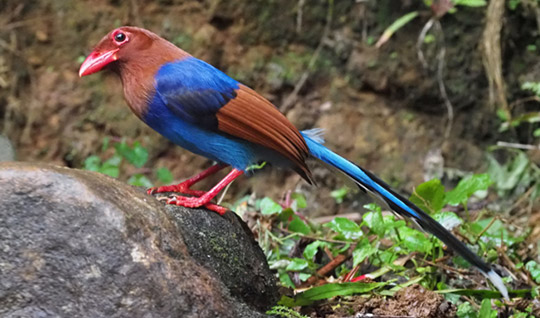
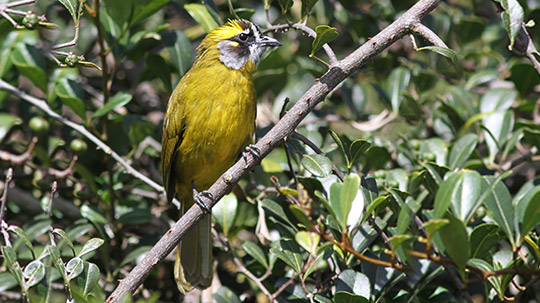
Yellow-eared Bulbul (Pycnonotus penicillatus)
Noisy, conspicuous, and tame sums up the Yellow-eared Bulbul. For a group of birds that are speciose in Asia and sometimes, sorry to say it, a bit drab, this bubul sports an intricate plumage. While the body plumage reveals the standard yellowish green tones, the ear coverts have a set of golden, bristly tufts and a mixture of black and yellow on the head accentuate them even more. The species is restricted to the highlands and best seen around Nuwara Eliya and the Horton Plains.
Sri Lanka Bush Warbler (Elaphrornis palliseri)
The Sri Lanka Bush Warbler is the master skulker of all of the endemics. The best place to glimpse one is Horton Plains National Park where it prefers dense growth of ferns and low shrubs along the forest edge. It is a very distinct bush warbler with a relatively short tail and long bill and is currently classified as monotypic. If one is lucky enough to catch a glimpse of it sneaking through a tangle of ferns, it is clear that its posture and shape are very different from other bush warblers. Future studies may reclassify this unique species.
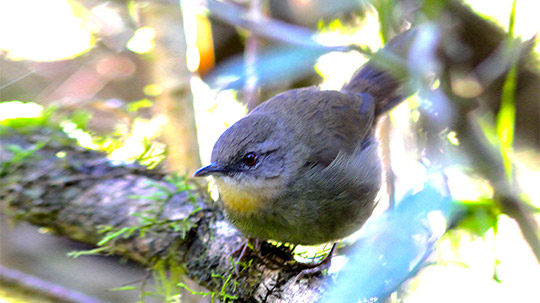
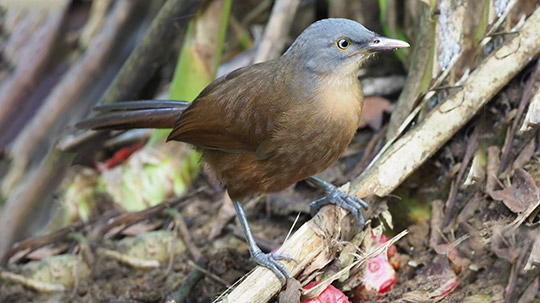
Ashy-headed Laughingthrush (Garrulax cinereifrons)
This garrulous species travels in large family groups, often accompanying mixed flocks as they forage on or near the forest floor. These groups wander widely and keep mainly to the interior of the forest. Birders may carefully walk along the trail in Sinharaja, listening, scanning, and discovering no laughingthrushes, only to have a noisy group appear out of nowhere while dejectedly walking back. The birds move with speed as they search the leaf litter for larger insects, snails, seeds, and fruits. It is a rather plain member of a family that includes some of the gaudiest birds in Asia, but its medium size, bright eye, grey head, and brownish body plumage are distinctive.
Spot-winged Thrush (Geokichla spiloptera)
This attractive thrush is bold, confiding, and often hops around the middle of the trail, pulling worms out of the wet earth with gusty. The namesake spots on its wing are not the only field mark, but it is also heavily spotted on its underparts with marked black patches below the eye and on the cheek. Its confident nature makes it a favorite among the endemics and it readily poses for photographs. This species is sedentary and its melodious song is heard at dawn and dusk. The species is very common and tame in the Sinharaja Forest Reserve.
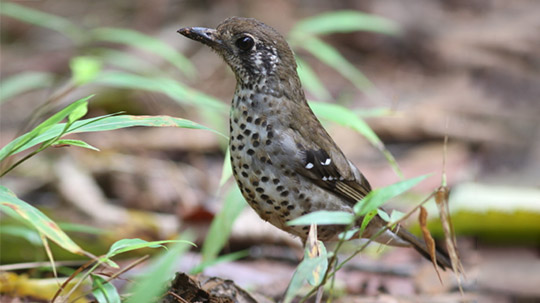
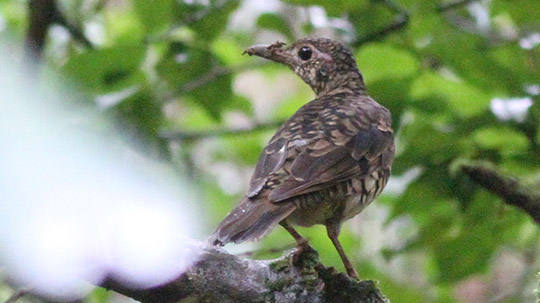
Sri Lanka Thrush (Zoothera imbricata)
This secretive thrush takes the top spot as the most difficult endemic to see right alongside the Sri Lanka Spurfowl. It is a large and heavy billed Zoothera thrush and like many species in the genus can be shy and elusive. It is restricted to the wetter southwestern portion of Sri Lanka where it occurs from the mountains to hills. It is overall dark brown with a strong scaly pattern and prefers to feed on the ground with lots of leaf litter and moist soil. The best clue to its presence are high pitched contact calls that are almost inaudible among the pitter-patter of the rainforest. Quietly walking along narrow trails and scanning the forest floor ahead is a decent recipe for success. During most tours, this is the last holdout of the thirty-four endemics and when an individual finally emerges from a tangle, occasionally flushing to an open perch, there is cause for celebration.
